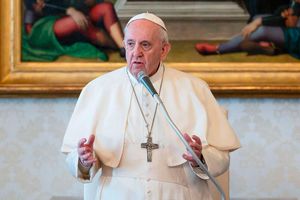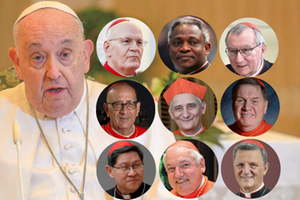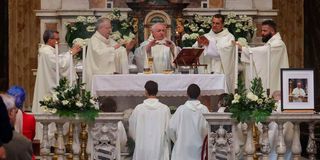
Cardinal Jean Marc Aveline presides over a Sunday Mass in Santa Maria ai Monti church on May 4, 2025, ahead of the Conclave and the election of the new pope, which will start on May 7, in Rome, Italy.
Tomorrow, May 7, 2025, one hundred and thirty-three cardinals from around the world will gather inside the Sistine Chapel for an event that is both sacred and solemn, a Conclave, to elect the 267th successor of St. Peter.
Following the death of Pope Francis on April 21, church law dictates that the election must begin within 15 to 20 days, hence Wednesday’s start. But what exactly is a conclave, and how does it unfold? Who takes part and under what rules? By what process do the cardinals reach their decision? And when might we realistically expect to see the announcement of a new pope?
Simply, a conclave is the process by which the Catholic Church elects a new pope. Guided by detailed legislation and immersed in prayer, it combines transparent rules with strict secrecy behind the sealed doors of the Sistine Chapel.
The cardinals, guided by ancient rites as well as modern governance, will draw on centuries‑old law and prayer, weigh the needs of a 1.4 billion‑member Church, and cast secret ballots until one of them secures a two‑thirds majority of the votes, to become the next pope. The process typically unfolds over two to four days, though it can extend if consensus is not reached. The conclave is governed first and foremost by Pope John Paul II’s apostolic constitution Universi Dominici Gregis (1996), as amended by Benedict XVI and Francis, which lays down the rules for elector eligibility, voting procedures, and sequestration. A companion prayer book, the Ordo Rituum Conclavis (1998), prescribes the liturgies, invocations, and oaths that sanctify the election as a work of the Holy Spirit.
Once the sede vacante (“vacant see”) begins, the Camerlengo (now Cardinal Farrell), seals the doors of the Sistine Chapel and adjacent areas; Swiss Guards bar any unauthorised entry or exit, ensuring cardinals remain physically and electronically cut off from the world. Two trusted technicians guard against any audio‑visual equipment in the chapel, and any breach of secrecy carries canonical penalties, even excommunication.
Only cardinals under age 80 on the day the Holy See became vacant may vote. Initially, 135 were eligible; however, Cardinal Antonio llovera of Spain and our own Kenya’s Cardinal Njue, withdrew due to health reasons, reducing the expected electors to 133.
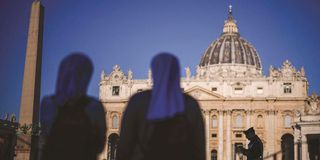
Carabinieri members walks in front of St. Peter's Basilica on April 29, 2025 as nuns stand in St. Peter's Square ahead of the Conclave which will be held on May 7, at the Vatican.
This is the largest conclave in the history of the Catholic Church. These electors represent 71 countries: Europe (51), Asia (23), the Americas (37), Oceania (5), and Africa (17). Africa’s growing voice is reflected in the 17 expected present, whom we hope will press for pastoral priorities in the rapidly expanding church in Africa.
A two‑thirds majority of participating electors (89 votes if 133 attend) will be required to elect the pope. The majority of the voters were appointed by Francis (about 80 per cent), many from the Global South, and will be voting together for the first time, which may diversify perspectives in the conclave deliberations. Although explicit campaigning is forbidden, informal alliances form organically around language, regional affinity, or theological outlook. Africa’s 17 voters, along with their global colleagues, will determine not only the next pope’s identity but the Church’s direction in an era of rapid change.
According to Vatican News, Cardinal Giovanni Battista Re, Dean of the College of Cardinals, will preside at the votive Mass for the Election of the Pope (Pro Eligendo Romano Pontifice), which will be celebrated at 10am in St. Peter’s Basilica. The conclave will officially begin at 4:30pm with a prayer service in the Pauline Chapel, attended by the Cardinal electors who will pray the Litany of the Saints before entering in procession into the Sistine Chapel. They will sing the Veni Creator and then make their solemn oath to faithfully fulfil the Munus Petrinum if they are elected Pope and to maintain absolute secrecy regarding the conclave.
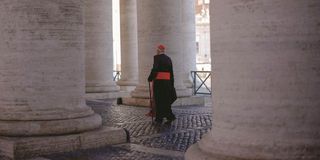
A cardinal walks in St. Peter's Square ahead of the conclave which will be held on May 7, at the Vatican, April 29, 2025.
Each voting day begins with Morning Prayer (Liturgy of the Hours) and concelebrated Mass and ends with evening prayer; before each ballot, cardinals spend time in silent prayer and reflection. On Day 1, one ballot may be cast in the afternoon; n subsequent days, two ballots each morning and afternoon, up to four per day.
It is highly unlikely to get the required majority with the first ballot, meaning that it is very unlikely we could get a new pope on the first day of the conclave. If, however, no candidate achieves two‑thirds after three days, ballots pause for a day of extended prayer and informal discussion, guided by a designated cardinal preacher.
In modern times, conclaves average 3.2 days (2005 and 2013 each took two days) and rarely exceed five; the longest (1268–1271) lasted nearly three years. Observers anticipate a swift decision in this conclave, mostly within the first three days. We must, however, remain mindful that the Holy Spirit sometimes works in ways we least expect.
After each ballot, ballots are burned with chemicals: black smoke (fumata nera) signals no decision; white smoke (fumata bianca) and the ringing of St. Peter’s bells signal a pope has been chosen. The new pope is then asked if he accepts and what name he will take. He dons white vestments in the “Room of Tears,” is presented to the College, and then the senior cardinal deacon proclaims “Habemus Papam” from the central balcony.
The writer is OPDirector – Institute of Social Communication, Tangaza University

